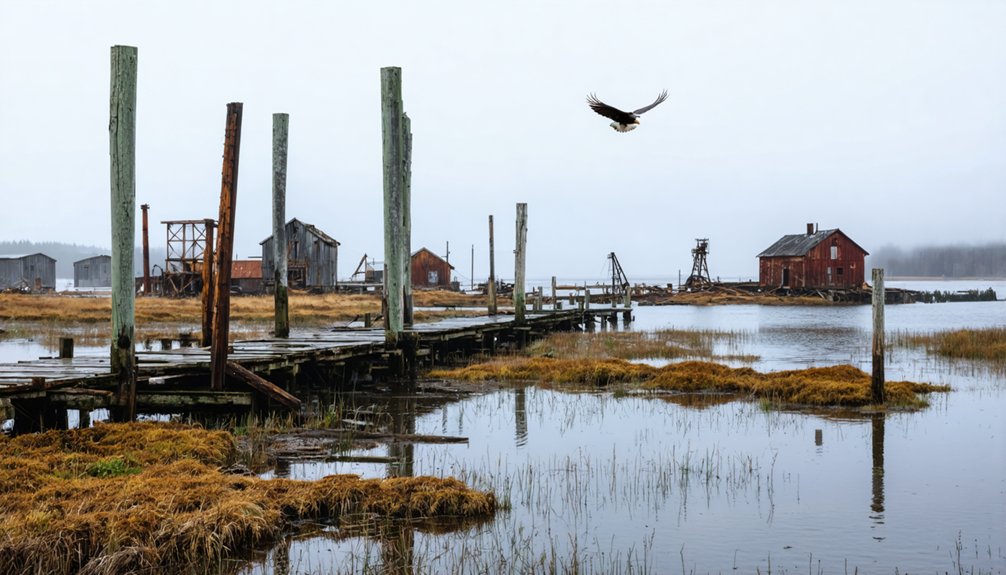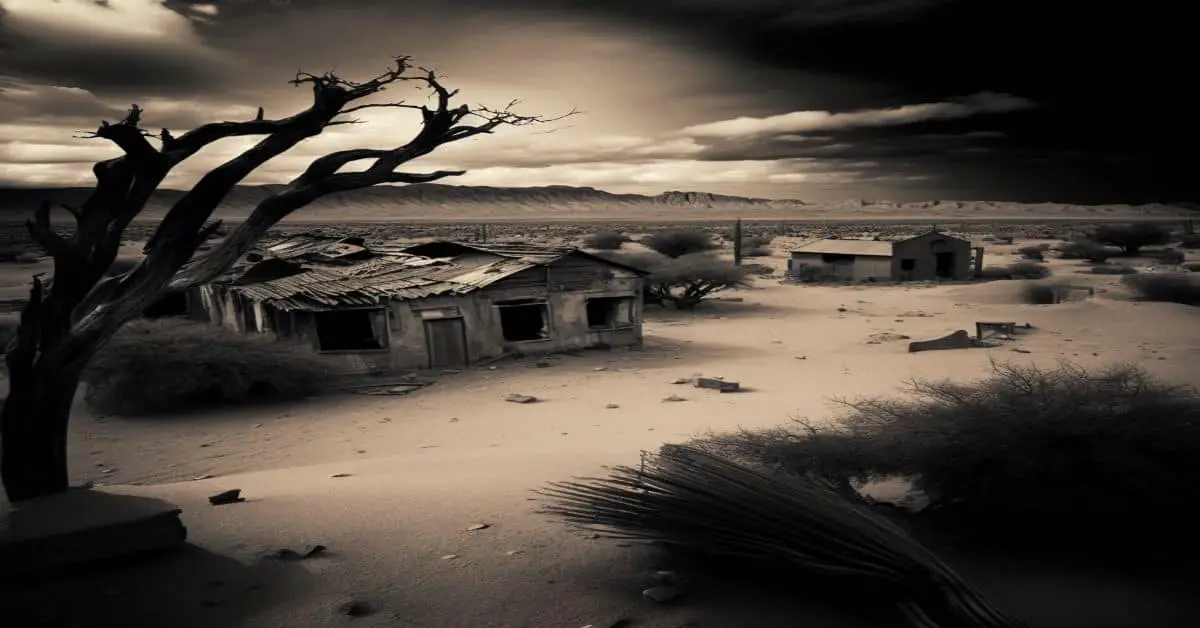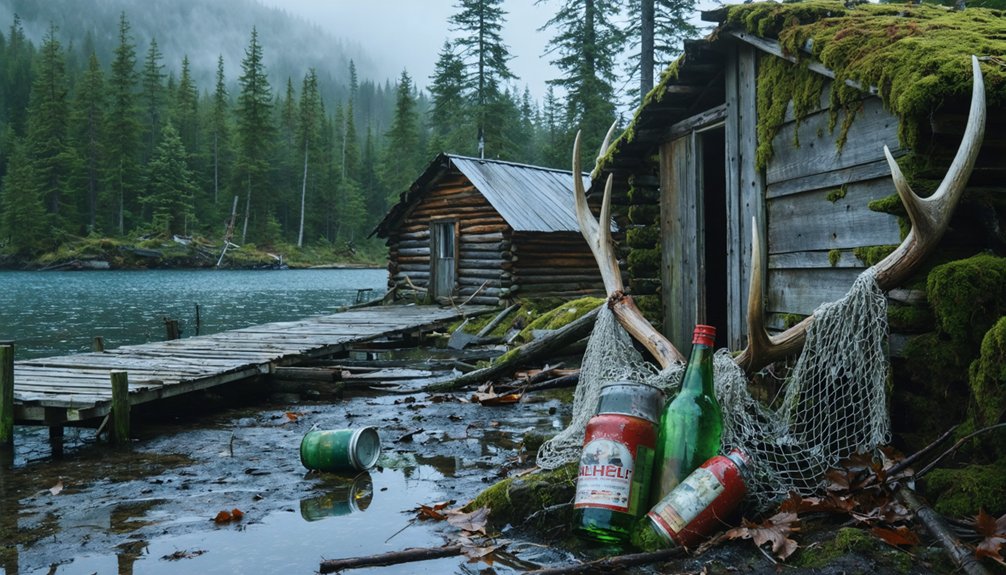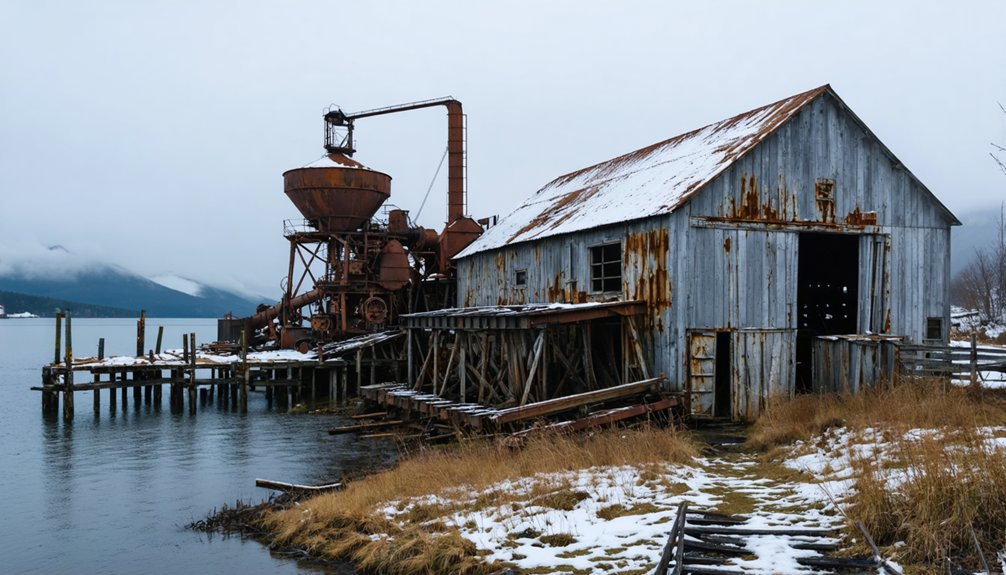Katalla became Alaska’s first oil boomtown in 1902 when oil seeps were discovered along the Katalla River. You’ll find this ghost town‘s dramatic story unfolds from a peak population of 5,000 to complete abandonment by 1933. Violent storms destroyed critical infrastructure, including the breakwater and dock, while the railroad’s decision to route through Cordova sealed the town’s fate. Today, rusted equipment and ruins of the Chilkat Oil Company Refinery tell tales of frontier ambition and nature’s resistance.
Key Takeaways
- Katalla was Alaska’s first oil boomtown, peaking at 5,000 residents in 1907 before devastating storms destroyed critical infrastructure.
- The town’s decline began when the railroad terminus moved to Cordova, reducing the population from 5,000 to 770 residents.
- A Christmas Day fire in 1933 destroyed the Chilkat Oil Company Refinery, marking the end of Katalla’s oil production era.
- Nature has reclaimed most of the town, leaving only scattered ruins, collapsed buildings, and rusted oil field equipment.
- The abandoned town site contains remnants of Alaska’s first oil refinery and the infamous “Katalla Madhouse” saloon.
The Rise of Alaska’s First Oil Boomtown
When prospectors discovered visible oil seeps and gas bubbles along the Katalla River in 1902, Alaska’s first commercial oil boom began.
The Alaska Development Company made the historic oil discovery, sparking a wave of excitement that even caught the attention of the New York Times, which erroneously reported a 200-foot gusher.
You’d have witnessed a dramatic boomtown transformation as the landscape quickly filled with derricks, cabins, and pipelines, while temporary storage pits dotted the surrounding bog.
Initial testing revealed that Katalla was producing Pennsylvania quality crude from its wells.
The town’s population exploded to nearly 5,000 within six years, as prospectors and workers flocked to this frontier outpost.
Katalla emerged as a symbol of Alaska’s untapped potential, marketing itself as “Where the Rails Meet the Sails” with ambitious plans for railway connections to the Pacific.
However, the town’s decline began when a devastating jetty destruction in 1907 forced the railroad terminus to be relocated to Cordova instead.
From Wilderness to Bustling Port
Despite its remote location on Controller Bay, Katalla transformed from untamed wilderness into a promising port settlement that attracted thousands of fortune seekers.
From wild frontier to bustling boomtown, Katalla drew ambitious settlers seeking their fortunes on Alaska’s untamed shores.
However, the lack of a natural harbor depth severely limited the town’s growth potential.
You would’ve found a town bustling with prospective industries, driven by nearby oil seeps and coal deposits that beckoned early explorers.
The Petroleum and Coal Company formed in 1903 to capitalize on the region’s resources.
The Alaska Pacific Railway and Terminal Company’s vision for Katalla included:
- An ambitious 1,800-foot dock to serve transportation routes
- A strategic terminal connecting Alaska’s interior copper mines
- A promising hub where “the Rails Meet the Sails”
In its prime, you’d have witnessed a population of 5,000 residents as the settlement became central to Alaska’s early oil industry.
Development surged forward with a refinery established in 1911, processing crude from local wells and solidifying Katalla’s position as Alaska’s first commercial oil producer.
Black Gold Beneath the Glaciers
As the Alaska Development Co. made its historic commercial oil discovery in September 1902, Katalla’s destiny shifted dramatically.
You’d have witnessed oil naturally seeping from the ground, bubbling to the surface – a tantalizing hint of the black gold beneath. Initial oil exploration efforts were primitive, with workers digging deep pits in the bog to store the precious resource due to a lack of proper tanks.
The discovery sparked a media frenzy, with The New York Times publishing exaggerated claims that drew thousands of prospectors and investors. Many companies employed unscientific drilling methods, leading to numerous unsuccessful wells across the region. While oil was the primary focus, some enterprising settlers also pursued placer gold mining in nearby creeks, following the pattern seen throughout Alaska’s resource-rich territories.
Within six years, you’d have found yourself among nearly 5,000 residents in this bustling frontier town.
However, the environmental impact proved challenging – violent storms battered the unprotected shore, while unstable slopes and periodic glacial dam outbursts from Bering Lake threatened development efforts.
Challenges of Nature and Development
As you explore Katalla’s troubled history, you’ll find nature’s fierce resistance to development exemplified by violent storms that thwarted railroad construction and made the harbor notoriously dangerous for ships.
You can trace how treacherous weather patterns and unstable coastal conditions repeatedly frustrated attempts to establish reliable transportation infrastructure in the area.
Through decades of abandonment, the surrounding wilderness has steadily overtaken the old oil fields, with vegetation concealing the remnants of derricks and industrial equipment that once dotted the landscape. The environmental challenges that doomed Katalla mirror those faced by 31 Native Alaskan communities today grappling with devastating flooding and coastal erosion. Like Newtok’s residents, who endured homes with deteriorating foundations and structural damage, the harsh Alaskan climate proved relentless in its assault on human settlement.
Weather Halts Rail Plans
While Katalla showed early promise as a crucial rail terminus for Alaska’s resource development, violent storms in late 1907 delivered a devastating blow to those ambitions. The weather disruptions destroyed an 1,800-foot dock and breakwater under construction by the Copper River and Northwestern Railway, isolating the town for six weeks.
The Morgan and Guggenheim interests relocated their operations to Cordova after the devastating storm damage. The rail construction efforts faced insurmountable challenges:
- The Alaska Pacific Railway struggled with funding shortages and waning investor interest
- Weather-related destruction forced a strategic shift of the rail terminus to Cordova
- The Alaska Anthracite Railroad’s planned connections to Controller Bay were never completed
These setbacks proved catastrophic for Katalla‘s future, as the population plummeted from 5,000 to 770 residents. The Alaska Syndicate had originally established operations there in 1907 before departing for the Copper River region.
Without reliable rail and maritime connections, the town’s role as a transportation hub quickly diminished.
Treacherous Harbor Access
Despite its strategic location on Controller Bay, Katalla’s harbor proved treacherously difficult to develop and maintain. You’d have faced constant maritime hazards, with violent storms battering the coast so frequently that locals called it “where storms are born.”
In 1907, these fierce weather conditions demolished an 1,800-foot dock and breakwater under construction, marking one of many infrastructure failures.
The natural barriers you’d encounter included dense vegetation, swampy flats, and numerous streams that made overland access challenging.
Even if you’d managed to reach the harbor, seasonal tidal variations and shallow river mouths severely restricted navigation windows.
These persistent challenges ultimately contributed to Katalla’s isolation when the railroad terminus moved to Cordova, 50 miles west, effectively ending hopes for sustained economic development.
Nature Reclaims Oil Fields
Once commercial oil operations ceased in 1933, Katalla’s industrial legacy began its slow surrender to nature.
You’ll find the area’s ecosystem restoration largely left to natural processes, with poorly drained wetlands now dominating where industrial equipment once stood. The distinction between man-made pollution and natural oil seeps has blurred over time, creating a complex environmental puzzle.
Today, you can observe:
- Visible hydrocarbon sheens in marshy wetlands near Oil Creek and Arvesta Creek
- Abandoned equipment and industrial remnants scattered throughout the landscape
- Natural oil seeps coexisting with century-old industrial impacts
The area’s remoteness has limited human interference, allowing nature to gradually reclaim the landscape.
However, the environmental impact of Katalla’s oil boom remains evident, with contamination challenges persisting in this sparsely inhabited region.
The Slow Fade Into History
After reaching its peak population of 5,000 residents in 1907-1908, Katalla’s descent into ghost town status began with a series of devastating setbacks.
You’ll find that violent storms destroyed critical infrastructure, including the breakwater and 1,800-foot dock, while the railroad’s decision to use Cordova as its terminus dealt a blow to the town’s economic resilience.
The cultural heritage of this once-bustling boomtown, known for its notorious “Katalla Madhouse” saloon, couldn’t withstand the mounting challenges.
What Remains Today: A Remote Historical Site
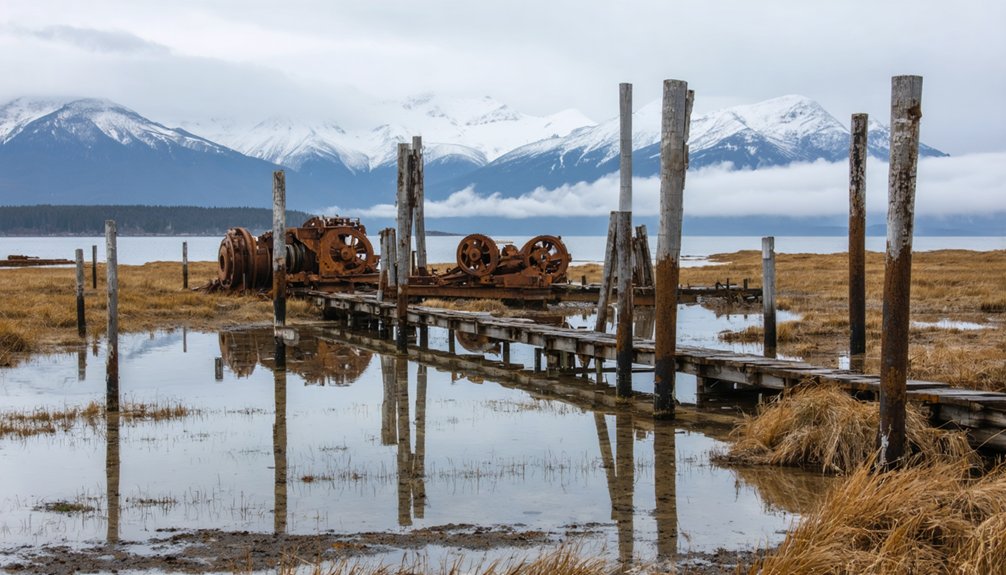
If you venture to Katalla’s remote location today, you’ll find the remnants of Alaska’s first oil refinery still standing amid the dense forest growth of the Chugach National Forest.
The historic Chilkat Oil Company Refinery, which produced over 50,000 gallons of gasoline in 1921, remains largely intact despite its abandonment after a Christmas Day fire in 1933.
Beyond the industrial ruins, the natural landscape has reclaimed much of the former boomtown’s footprint, with the rugged terrain and subarctic climate continuing to shape this historic site near Controller Bay.
Visible Historic Ruins Today
Today’s visitors to Katalla encounter scattered ruins that tell the story of Alaska’s first oil boom town. The site’s archaeological significance lies in its deteriorating industrial remnants and structural foundations, offering glimpses into early 20th-century frontier development.
You’ll find historic preservation challenges evident throughout the landscape, where harsh weather and coastal erosion continue to reshape the remaining features.
- Rusted oil field equipment and broken pipeline remnants mark the 1902 commercial discovery site
- Collapsed buildings and deteriorated timbers outline where the notorious “Katalla Madhouse” saloon once stood
- Fragmentary rail grades and damaged trestle remains hint at abandoned transportation networks
The ruins you’ll discover are slowly being reclaimed by nature, with vegetation overtaking building foundations while personal artifacts occasionally surface through eroded soil.
Natural Landscape Still Dominates
The rugged wilderness of Katalla stands virtually unchanged since its oil boom days, with pristine forests, glacial streams, and dramatic mountain peaks dominating the landscape.
You’ll find yourself surrounded by the natural beauty of the Chugach National Forest, where Mount Hazelet and Ragged Mountain rise above the tree line.
The area’s ecological diversity spans from pristine waterways like the Katalla River and Bering Lake to scattered islands including Fox, Kanak, and Whale Island.
You’re likely to encounter challenging weather conditions, as storms frequently sweep through this subarctic region.
The remote location‘s limited access, primarily by private aircraft or river routes at low tide, has helped preserve its untamed character.
Multiple glaciers still cling to the higher slopes, feeding the network of streams below.
Frequently Asked Questions
Are There Any Living Former Residents of Katalla Still Alive Today?
While you might wish to find former residents from this historic ghost town, there’s no evidence of any living survivors today – the last permanent residents left Katalla nearly 80 years ago.
What Was the Average Daily Wage for Oil Workers in Katalla?
You won’t find exact wage records for Katalla’s oil industry workers, though early 1900s wage standards suggest they likely earned a few dollars per day, far below today’s Alaska oil wages.
How Much Would a Barrel of Katalla Oil Cost in 1907?
You’d have found Katalla’s oil price ranging from $1.25 to $1.75 per barrel in 1907, reflecting both the national historical context and local premium for its high-quality “Pennsylvania-grade” crude.
Were There Any Schools or Churches Established During Katalla’s Boom Period?
You won’t find evidence of education facilities or religious institutions during Katalla’s boom period. Historical records and archaeological surveys show no schools or churches existed in this rough, industrial-focused boomtown.
Did Any Indigenous Communities Live in the Katalla Area Before Development?
Yes, you’ll find rich indigenous history in the area, where Eyak, Alutiiq, Tlingit, and Athabaskan peoples lived sustainably for generations. The region held cultural significance as their traditional homeland.
References
- https://akoghs.org/territory-boom-town-where-rails-meet-sails/
- https://www.peninsulaclarion.com/life/an-outdoor-view-fishing-at-a-ghost-town/
- https://aoghs.org/petroleum-pioneers/first-alaska-oil-well/
- https://www.litsitealaska.org/index.cfm?section=digital-archives&page=Industry&cat=Oil-and-Gas&viewpost=2&ContentId=2747
- https://www.thealaskalife.com/blogs/news/alaska-ghost-towns-youve-probably-never-heard-of
- https://www.fs.usda.gov/r10/natural-resources/arch-cultural/chilkat-oil-company-refinery
- https://www.seniorvoicealaska.com/story/2025/09/01/local/first-oil-rush-fueled-the-rise-and-demise-of-katalla/4035.html
- https://www.alaska.org/detail/katalla
- https://en.wikipedia.org/wiki/Katalla
- https://www.akbizmag.com/industry/oil-gas/making-history-the-future-of-petroleums-past/
